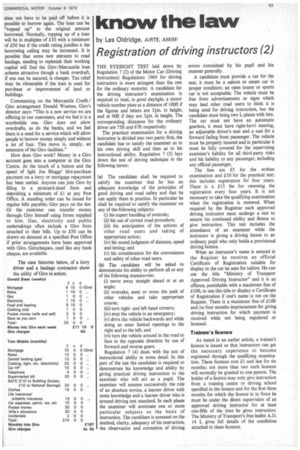know the law
Page 65

If you've noticed an error in this article please click here to report it so we can fix it.
by Les Oldridge, AIRTE, AMIM1
Registration of driving instructors (2)
THE EYESIGHT TEST laid down by Regulation 7 (2) of the Motor Car (Driving Instruction) Regulations 1969 for driving instructors is more stringent than the one for the ordinary motorist. A candidate for the driving instructor's examination is required to read, in good daylight, a motor vehicle number plate at a distance of 100ft if the figures and letters are 34-in. in height, and at 90ft if they are 3kin. in height. The corresponding distances for the ordinary driver are 75ft and 67ft respectively.
The practical examination for a driving instructor is divided into two parts: first, the candidate has to satisfy the examiner as to his own driving skill and then as to his instructional ability. Regulation 7 (3) lays down the test of driving technique in the following terms: (a) The candidate shall be required to satisfy the examiner that hehas an adequate knowledge of the principles of good driving and road safety and that he can apply them in practice. In particular he shall be required to satisfy the examiner on any of the following subjects: (i) his expert handling of controls; (ii) his use of correct road procedure; (iii) his anticipation of the actions of other road users and taking of appropriate action; (iv) his sound judgment of distance, speed and timing; and (v) his consideration for the convenience and safety of other road users.
(b) The candidate will be asked to demonstrate his ability to perform all or any of the following manoeuvres: (i) move away straight ahead or at an angle; (ii) overtake, meet or cross the path of other vehicles and take appropriate course; (iii) turn rightand left-hand corners; (iv) stop the vehicle in an emergency; (v) drive the vehicle backwards and while doing so enter limited openings to the right and to the left; and (vi) turn the vehicle around in the road to face in the opposite direction by use of forward and reverse gears.
Regulation 7 (4) deals with the test of instructional ability in some detail. In this part of the test the candidate is required to demonstrate his knowledge and ability by giving practical driving instruction to the examiner who will act as a pupil. The examiner will assume successively the role of an absolute novice, a learner driver with some knowledge and a learner driver Who is around driving test standard. In each phase the examiner will nominate one or more particular subjects as the basis of instruction. The candidate is assessed on the method, clarity, adequacy of his instruction, the observation and correction of driving errors committed by his pupil and his manner generally.
A candidate must provide a car for the test; it must be a saloon or estate car in proper condition; an open tourer or sports car is not acceptable. The vehicle must be free from advertisements or signs which may lead other road users to think it is being used for driving instruction, but the candidate must bring two L-plates with him. The car must not have an automatic gearbox, it must have right-hand steering, an adjustable driver's seat and a seat for a forward fading front passenger. The vehicle must be properly insured and in particular it must be fully covered for the supervising examiner's liability for all third-party risks and his liability to any passenger, including any official passenger.
The fees are £5 for the written examination and £10 for the practical test; this includes registration for four years. There is a £15 fee for renewing the registration every four years. It is not necessary to take the qualifying examination when the registration is renewed. When required by the Registrar each approved driving instructor must undergo a test to ensure his continued ability and fitness to give instruction. This test includes the attendance of an examiner while the instructor is giving a driving lesson to an ordinary pupil who only holds a provisional driving licence.
When an instructor's name is entered in the Register he receives an official Certificateof Registration suitable for display in the car he uses for tuition. He can use the title "Ministry of Transport Approved Driving Instructor" and it is an offence, punishable with a maximum fine of £100, to use this title or display a Certificate of Registration if one's name is not on the Register. There is a maximum fine of £100 and/or four months imprisonment for giving driving instruction for which payment is received while not being registered or licensed.
Trainee's licence
As stated in an earlier article, a trainee's licence is issued so that instructors can get the necessary experience to become registered through the qualifying examination. These licences cost £1 and last for six months; not more than two such licences will normally be granted to one person. The holder of a licence may only give instruction from a training centre or driving school specified in the licence and for the first three months for which the licence is in force he must be under the direct supervision of an approved driving instructor for at least one-fifth of the time he gives instruction. The Ministry of Transport's free leaflet A.D. 14 L gives full details of the conditions attached to these licences.








































































































